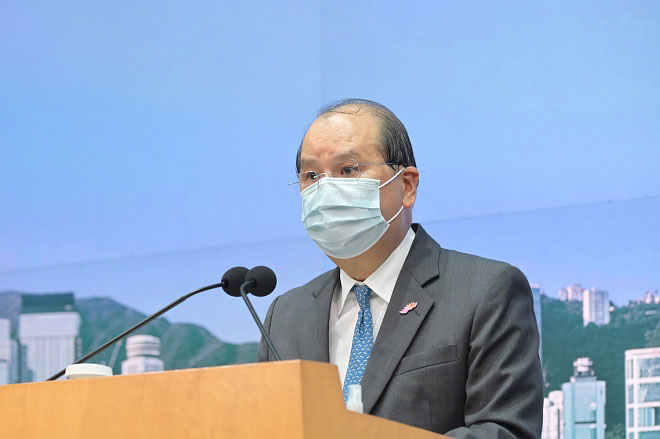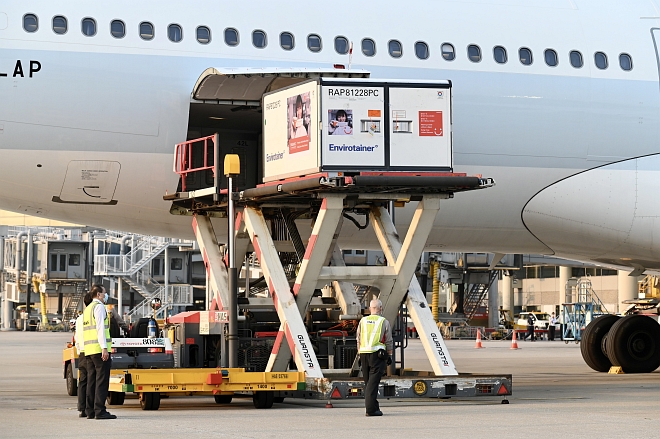Sinovac provides a shot in the arm Remain vigilant and don't let guard down
21 February 2021

|

|
Vaccination is a top priority in our anti-COVID-19 measures. With the full support of the Central Government and the active co-operation of Sinovac, the first batch of about one million doses of the Mainland-produced Sinovac vaccine arrived from Beijing on February 19. This is an exciting moment for all of us as we are in grave need of assistance. This marks a new milestone in our anti-epidemic work.
The HKSAR Government has since rolled out a territory-wide COVID-19 Vaccination Programme1. Starting this Tuesday (February 23), people belonging to the five priority groups for vaccination2 may make appointments to receive the Sinovac vaccine at five designated Community Vaccination Centres (CVC) and 18 general out-patient clinics of the Hospital Authority (HA) from this Friday (February 26) onwards. In addition, the first batch of one million doses of the German-produced BioNTech vaccine are expected to arrive by the end of this month, which will be available for inoculation at 24 designated CVCs.
The vaccination service is also available in 1 500 or so clinics of over 1 200 private doctors participating in the vaccination programme. They are expected to start providing the Sinovac vaccine to the public free of charge by mid-March. For residents of residential care homes for the elderly, nursing homes and persons with disabilities, the Government will arrange for outreach vaccination teams comprising doctors and nurses to give them the jabs.
Active participation by all
The HKSAR Government has made full preparation for the provision of free vaccination services at CVCs in all 18 districts across the territory, and civil servants are being deployed to provide timely support. On February 1, the Civil Service Bureau (CSB) invited all Permanent Secretaries and Heads of Departments to nominate serving civil servants to perform administrative duties at CVCs and render administrative support for the vaccination programme. Over 1 000 nominations for posts involving different work shifts were received in just 10 days. It is encouraging to see our colleagues' enthusiastic response to participating in the vaccination programme. The number of CVCs has increased from about 20 at the planning stage to 29 at present.
To ensure the safe, orderly and smooth operation of the CVCs, CSB, together with relevant departments and HA, conducted a trial run at one of the CVCs on February 1, focusing on the procedures inside the CVCs, the collaboration between medical staff and administrative supporting staff and the handling of emergency situations. Up to 300 members of staff participated in the exercise.
Besides, three briefings, each lasting for around three hours, were held on February 16 to brief some 2 000 civil servants and healthcare personnel from the public and private sectors on the mode of operation of and precautions to be taken in the CVCs.
With public interest in mind and sharing the common goal of ending the epidemic in Hong Kong as soon as possible, civil servants participate in anti-epidemic operations with their best effort. Their active participation and solid support have helped enhance the Government's anti-epidemic capacity. I would like to thank them again for their contribution.
Grasping accurate information to be rid of worries
The work of the Government in vaccine administration will be based on scientific evidence and will adhere to the principles of openness and transparency. Free vaccination will be provided to all Hong Kong residents in a gradual and orderly manner. At the same time, the Government will continually monitor the use of the vaccines. I am confident that the public's willingness and confidence in vaccination will increase with time.
When implementing the vaccination programme, the Government will adopt a science-based approach and ensure the proper conduct of information dissemination, promotion and education work under the principles of openness, transparency, accuracy and timeliness. We will disseminate information on the benefits and facts about the vaccination, experts' opinions, details of the vaccination programme, etc. to members of the public through various channels to keep them fully informed about the principles, formulation, efficacy, side effects and other relevant facts of the vaccines before getting the jab, thereby allaying their worries. Should there be false information on the vaccines spreading in the community, the Government will make clarifications and debunk the rumours immediately.
One-stop website for dissemination of information to the public
The Government has launched a COVID-19 Vaccination Programme website which provides official and up-to-date information about COVID-19 vaccines to the public on a one-stop basis. The website is linked to an online booking system where members of the public can reserve a time slot at a chosen location for vaccination. The booking process will involve filling in some brief personal information and contact phone number, as well as selecting the CVC and time slots for receiving two vaccine doses. Upon completion of the process, an SMS message containing the date, time and place of vaccination for the two doses will be sent by the system. On the day before vaccination, another SMS message will be sent as a reminder. At the CVC, the healthcare staff will record the recipient's identity and detailed vaccination information using an efficient and convenient registration system with the aid of a Hong Kong identity card reader. After the injection, the healthcare staff will print a record of COVID-19 vaccination for the recipient. An electronic record is also available for download through the “iAM Smart” mobile app.
Stay on guard against COVID-19
Notwithstanding the upcoming start of the vaccination programme, it will take some time for the majority of our population to be vaccinated. Since last Thursday (February 18), the Government has begun to gradually and orderly relax the social distancing measures that were in place in the last two months. Despite the subsidence of the epidemic and the arrival of vaccines, I would like to remind members of the public that they should not let down their guard, but should instead strictly comply with the Government's anti-epidemic measures and maintain their personal hygiene and alertness to the disease. At the same time, I hope that they will record their visits with the “LeaveHomeSafe” mobile app when entering and leaving various venues. Thanks to the support of the general public, as at last night (February 20), the “LeaveHomeSafe” mobile app has recorded over 2.33 million cumulative downloads, more than doubled the number of 700 000 mentioned in my last blog article. This is indeed encouraging.
Conclusion
The Central People's Government attaches great importance to Hong Kong's epidemic situation and cares deeply about the health and well-being of Hong Kong people. The first batch of the Mainland-manufactured vaccines will not only strengthen our anti-epidemic work, but also facilitate the early recovery of our economy, the return to our normal life and the resumption of people flow between Hong Kong and the Mainland. The arrival of the Mainland-made vaccine has indeed given the city a shot in the arm.
No one in Hong Kong would like to see the emergence of a fifth-wave epidemic. Actually, the more people receiving the vaccination, the greater the chance of slashing the risk of further outbreaks in the community, thus opening the door for Hong Kong to step out of the gloom. I appeal to all of you to play a part in this fight against the epidemic by getting vaccinated to protect yourselves and others.
1 For details, please refer to the related press release.
2 The Government has decided to arrange priority vaccination for the five groups below:
- Healthcare staff and staff involved in anti-epidemic work;
- Persons aged 60 or above (A maximum of two carers who accompany elderly people aged 70 or above can also receive vaccination);
- Residents and staff of residential care homes for the elderly and persons with disabilities;
- People providing essential public services; and
- People providing cross-boundary transportation or working at control points and ports.

